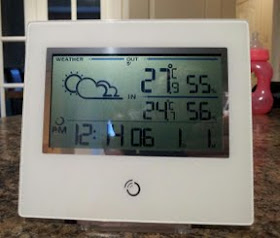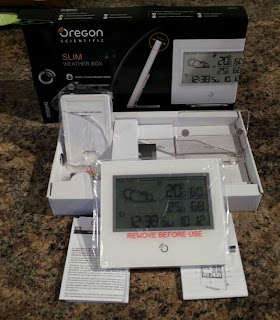Basically its a very smart clock with some weather assessement tools added on all in a very attractive iphone esque design.
Heres what oregon say on their website :
"The Ultra-Thin Weather Station is the height of design with its sleek profile and lustrous white finish. Ideal for use on a desk, on a wall, or next to a bed, you’ll have all the information you need to plan your day. Radio Controlled time is always precise and never needs adjusting.. Indoor and outdoor temperature and humidity keep you in the know, while an iconic weather forecast indicates future weather conditions."
Why
Well to be brutally honest, its because oregon sent me a unit to review!
Was i in the market for one? nope, i am however always up for reviewing items and this one had mean keen to see if it was any good.
I have in previous years bought one of the projection alarm clocks (not an oregon make) but i have to say aside from being "fun for 5 minutes" its usefulness was shortlived leaving me with a bulky alarm clock.
This "weather station" certainly had its work cut out, trying to prove its more than a glorified clock.
So onto the review, open and honest with no bias.
If i were looking for a weather station, what might my criteria be for choosing one?
looks
design
build quality
ease of use (including ability to toggle display options)
clarity of display
functions available
support and warranty
how unit is powered
Unboxing
Unboxing
Well labelled and thought out box design, very small which makes you think youve got the wrong item!
It really is a small box.
In the box are :
At this point you need to wait for the sensor to sync with the unit, i went and left it, but shouldnt take more than 30 minutes.
The sensor supplies clock and weather data to the main clock unit, so therefore is supposed to have a clear line of sight of the sky.
(Im unclear on whether this means it should be outside? my assumption is that the clock unit measures indoor temp, whilst the remote unit supplies all other values. but then Im confused at to how the humidity for inside/outside is measured and by which unit)
The first thing you notice is how nicely built the unit is, as well as some heavy apple design cues in terms of colours and finish. The clock unit is supremely thin and fits very well with modern decor.
The clock unit can be wall mounted (fixings supplied) or used with its own very slick perspex stand that attaches to the unit using magnets.
As with all of these type of 'remote' units, the biggest problem youll find is where to put the remote sensor.
(an easy solution is to put the clock unit on a window sill and stand the remote unit behind it)
Item worked straight out of the box and the weather/clock had synced correctly next time i went to play with it (1 hr later).
I have now tried the unit at home in our kitchen, and on my desk at work over the last month.
So here are my thoughts :
Plus points
- batteries for unit and sensor are provided in the box (top marks oregon)
- shock and surprise, but the weather forecasting function seems to be reasonably accurate
- well built for a gadget of this type
- seperate sensor allows free positioning of the clock unit anywhere you want
- stylish design : from a personal point of view the clear and white design is really classy and fits well with modern colours
- magnetic perspex stand is a neat touch
- clear design, easy to read display, buttons for toggling options easy to use.
- mid range reasonably priced at £49.99 for this type of product
- clock unit is very slim, about the size of a normal CD case
- Instructions are not necessarily clear as to where the remote sensor should be, and whether it should be outside or not
- limited to only one sensor (only one possible outside temp)
- not sure what happens if you lose the sensor!
- really, how useful is a 12-24hr forward forecast? in modern times I have a smartphone that does this.
Others to consider
The marketplace is pretty saturated with this type of gadget, so you really need to decide what criteria you are trying to fulfil before surfing the web.
Summary
Initially i was very sceptical that this weather station would be of any use at all.
Summary
Initially i was very sceptical that this weather station would be of any use at all.
However after several weeks, I'm very pleased that it does exactly what oregon state it should, accurately and in a very well designed and stylish case :-)
I have found myself actually using the internal and external temperatures, and of course the time/date.
The Oregon Scientific BAR800 Ultra Thin Weather Station, makes a welcome addition to any home, for yourself or as a gift for a friend.
If you are in the market for a weather station for a reasonable price, then id seriously consider this unit.
[UPDATE 31/10/11 : change in gmt for us moving into winter. I expected the weather station to have autoupdated to -1hr , alas it didnt and I had to do it manually!]
[UPDATE 31/10/11 No2 ! : ok so its so smart it auto-updated my corrected time to the wrong time (+1) again at some point today! So I have set the time zone offset to -1 by using the procedure below.
This fixes it for now but means it wont auto adjust during GMT / British summertime shifts twice a year, and will therefore need changed again march 2012
Sounds like a flaw to me. Shouldnt radio controlled alarms account for GMT changes ????
Anyway instructions on how to change offset below from the Oregon manual
MANUALLY SET CLOCK
To set the clock manually, disable the clock signal
reception first.
1. Press and hold MODE.
2. Press / to change the settings.
3. Press MODE to confirm.
The settings order is: time zone, 12/24 hr format, hour,
minute, year, calendar mode (month – day / day – month),
month, day and language.
Time zone offset sets the clock +/- 23 hours from the
received clock signal time.
NOTE If you enter + 1 in the time offset setting, this will
give you your local time plus one hour. If you are in the US
(BAR800A) set the clock to:
0 for Pacific time +1 for Mountain time
+2 for Central time +3 for Eastern tim]
[UPDATE 19/102013
added docs link for the manual online.
https://drive.google.com/file/d/0B_EbeXI3vAqlbXZQb3c2dnJ3OHM/edit?usp=sharing]
[UPDATE 31/10/11 No2 ! : ok so its so smart it auto-updated my corrected time to the wrong time (+1) again at some point today! So I have set the time zone offset to -1 by using the procedure below.
This fixes it for now but means it wont auto adjust during GMT / British summertime shifts twice a year, and will therefore need changed again march 2012
Sounds like a flaw to me. Shouldnt radio controlled alarms account for GMT changes ????
Anyway instructions on how to change offset below from the Oregon manual
MANUALLY SET CLOCK
To set the clock manually, disable the clock signal
reception first.
1. Press and hold MODE.
2. Press / to change the settings.
3. Press MODE to confirm.
The settings order is: time zone, 12/24 hr format, hour,
minute, year, calendar mode (month – day / day – month),
month, day and language.
Time zone offset sets the clock +/- 23 hours from the
received clock signal time.
NOTE If you enter + 1 in the time offset setting, this will
give you your local time plus one hour. If you are in the US
(BAR800A) set the clock to:
0 for Pacific time +1 for Mountain time
+2 for Central time +3 for Eastern tim]
[UPDATE 19/102013
added docs link for the manual online.
https://drive.google.com/file/d/0B_EbeXI3vAqlbXZQb3c2dnJ3OHM/edit?usp=sharing]



No comments:
Post a Comment